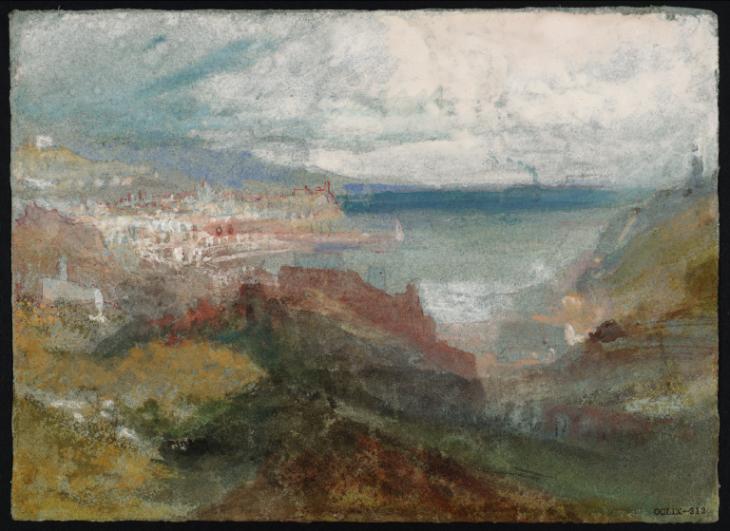This painting is executed in watercolour and gouache on a medium to heavy weight blue wove paper, of a type used frequently by Turner at this date. The paper has no watermark. All four edges of the sheet have been torn rather than cut.
In this composition the paint application is particularly dense and a heavy impasto is particularly evident in the white areas, such as the sky, where the artist has used an underbound lead white gouache to great effect. Some areas (such as the blue in the left-hand side of the sky) are more fluid in style; in these areas the amount of water mixed with the paint was clearly increased.
The blue of the paper has been used to great effect to represent the sea. Here the paper has been left to show through and, because of the sharp contrast with the surrounding impasto, a light and liquid appearance is created for the water. A scumbling technique has been used in the foreground to indicate grassland. The linear detailing in red watercolour, applied with a very fine brush, was the last thing to be added to the composition. The work is in good condition with the colours retaining much of their vibrancy.
There is some minor cockling across the surface of the sheet which was probably caused by the heavy impasto paint application. Adhesive staining is evident around the edges of the verso where the work has previously been inlaid onto another sheet.
Helen Evans
April 2009
Revised by Joyce Townsend
March 2011
How to cite
Helen Evans, 'Technique and Condition', April 2009, revised by Joyce Townsend, March 2011, in Matthew Imms, ‘Genoa from Inland c.1828–37 by Joseph Mallord William Turner’, catalogue entry, February 2016, in David Blayney Brown (ed.), J.M.W. Turner: Sketchbooks, Drawings and Watercolours, Tate Research Publication, November 2016, https://www.tate.org.uk/art/research-publications/jmw-turner/joseph-mallord-william-turner-genoa-from-inland-r1182958, accessed 03 April 2025.

